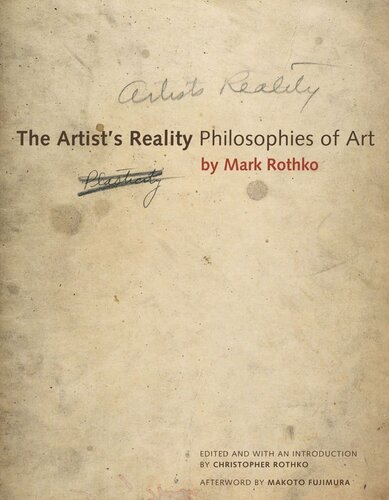

Most ebook files are in PDF format, so you can easily read them using various software such as Foxit Reader or directly on the Google Chrome browser.
Some ebook files are released by publishers in other formats such as .awz, .mobi, .epub, .fb2, etc. You may need to install specific software to read these formats on mobile/PC, such as Calibre.
Please read the tutorial at this link: https://ebookbell.com/faq
We offer FREE conversion to the popular formats you request; however, this may take some time. Therefore, right after payment, please email us, and we will try to provide the service as quickly as possible.
For some exceptional file formats or broken links (if any), please refrain from opening any disputes. Instead, email us first, and we will try to assist within a maximum of 6 hours.
EbookBell Team

4.7
86 reviewsMark Rothko’s classic book on artistic practice, ideals, and philosophy, now with an expanded introduction and an afterword by Makoto Fujimura
Stored in a New York City warehouse for many years after the artist’s death, this extraordinary manuscript by Mark Rothko (1903–1970) was published to great acclaim in 2004. Probably written in 1940 or 1941, it contains Rothko’s ideas on the modern art world, art history, myth, beauty, the challenges of being an artist in society, the true nature of “American art,” and much more.
In his introduction, illustrated with examples of Rothko’s work and pages from the manuscript, the artist’s son, Christopher Rothko, describes the discovery of the manuscript and the fascinating process of its initial publication. This edition includes discussion of Rothko’s “Scribble Book” (1932), his notes on teaching art to children, which has received renewed scholarly attention in recent years and provides clues to the genesis of Rothko’s thinking on pedagogy.
In an afterword written for this edition, artist and author Makoto Fujimura reflects on how Rothko’s writings offer a “lifeboat” for “art world refugees” and a model for upholding artistic ideals. He considers the transcendent capacity of Rothko’s paintings to express pure ideas and the significance of the decade-long gap between The Artist’s Reality and Rothko’s mature paintings, during which the horrors of the Holocaust and the atomic bomb were unleashed upon the world.